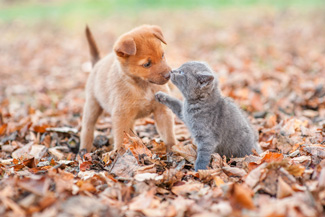Ever heard of "cute aggression?"
 “Oh, what a cute baby!” Have you noticed that some people (perhaps you yourself?) can't help pinching the cheeks of an infant they find really adorable? This phenomenon, known as “cute aggression,” is defined as a need to pinch, squeeze or even bite cute beings, without any desire to harm. Two researchers from the University of California at Riverside wanted to better understand this behavior by studying the underlying neural basis.
“Oh, what a cute baby!” Have you noticed that some people (perhaps you yourself?) can't help pinching the cheeks of an infant they find really adorable? This phenomenon, known as “cute aggression,” is defined as a need to pinch, squeeze or even bite cute beings, without any desire to harm. Two researchers from the University of California at Riverside wanted to better understand this behavior by studying the underlying neural basis. The "cute aggression” phenomenon was initially highlighted in a study by Aragón et al. (2015) that involved individual self-evaluations using images of baby humans and animals. The behavior was discussed as being the dimorphic expression of emotions: a person may experience a strong emotion, but express the opposite emotion. For example, we may laugh when we’re sad or cry when we’re happy. Take for example people who shed a tear during the happiest parts of a movie... From this point of view, “cute aggression” would be a mechanism for regulating overwhelmingly positive emotions. This study, led by Katherine KM Stavropoulos and Laura A. Alba aimed to identify and measure the neural underpinnings of this behavior. The scientists hypothesized that it’s linked to the brain's reward system, which processes motivation and feelings of pleasure, to the emotional processing system, or more likely, to both systems.
The researchers recruited 54 participants (20 men and 34 women) ages 18 to 40 (M = 20.05). An electrode helmet was used to record brain activity. The study used the same materials developed for the research conducted by Aragón et al (2015). Volunteers were randomly shown four series of thirty-two photos in the following categories: cute babies, less cute babies, cute baby animals, and less cute animals (adults). The photos of infants were modified so that they had more infantile characteristics (bigger eyes, fatter cheeks) in the “cute” condition than in the “less cute” condition (smaller eyes, thinner cheeks). After viewing each set of photos, the participants answered a survey to assess how cute they found each series and the kind of “cute aggression” they experienced in response. They were asked to indicate on a scale from 1 to 10 how much they agreed with a set of statements, such as: “I want to say something like grrr," “I want to squeeze something,” "I want to protect it," "I feel overwhelmed by positive feelings when I see these pictures," or "I can't stand it."
Overall, participants exhibited feelings of cute aggression towards cute baby animals (more than adult animals). However, researchers didn’t see any significant differences in the stated emotions between the two categories of human babies. The electrophysiological data during and after viewing the images confirmed that the "cute aggression" phenomenon is related to the neural mechanisms of emotion and reward processing.
Katherine KM Stavropoulos stated that these results seem to support the idea that, “cute aggression is the brain’s way of ‘bringing us back down’ by mediating our feelings of being overwhelmed.” According to her, this process of mediation is an evolutionary adaptation that allows us to care for very cute creatures. The author uses a concrete example to illustrate her point of view. You may be so struck by the adorableness of a baby that you aren't able to care for him or her. In this case, cute aggression could be used as a moderating mechanism that would allow you to override this reaction and take care of the baby.
The researchers hope to study the neural bases of cute aggression in other subjects, such as mothers with postpartum depression or people with autism spectrum disorders.
Source: Katherine KM Stavropoulos et Laura A. Alba, “It’s so Cute I Could Crush It”: Understanding Neural Mechanisms of Cute Aggression”, in Frontiers in Behavioral Neuroscience, Dec. 2018. University of California at Riverside website: https://news.ucr.edu/articles/2018/12/04/so-cute-you-could-crush-it Aragón, O. R., Clark, M. S., Dyer, R. L., and Bargh, J. A. (2015). Dimorphous expressions of positive emotion: displays of both care and aggression in response to cute stimuli. Psychol. Sci. 26, 259–273.







